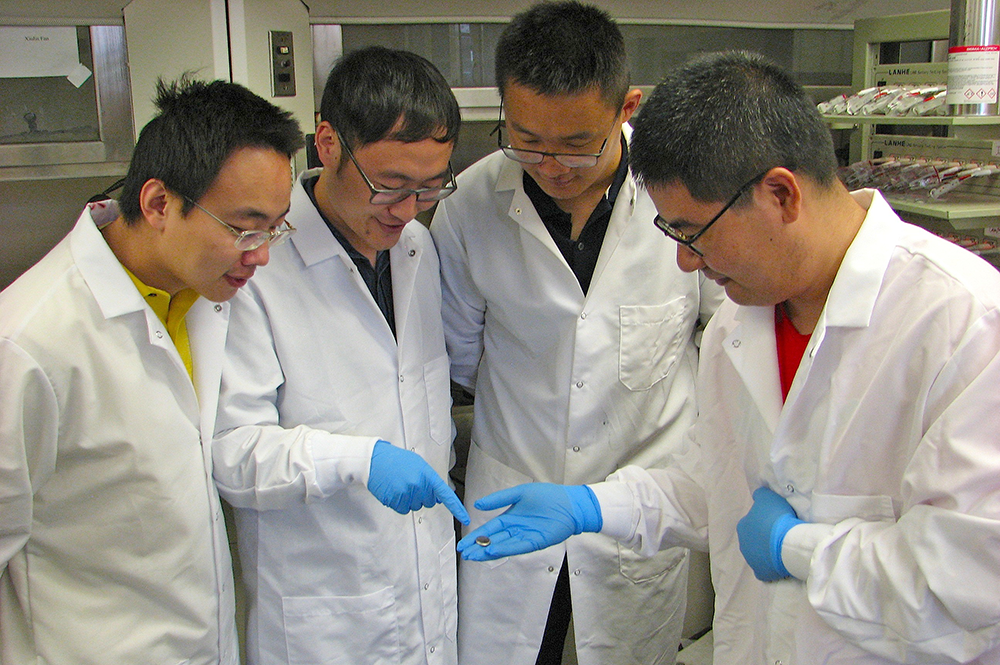UMD engineers, colleagues work to triple the energy storage of lithium-ion batteries
College Park, Md. — As the demand for smartphones, electric vehicles, and renewable energy continues to rise, researchers are searching for ways to improve lithium-ion batteries—the most common type of battery found in home electronics, a workhorse for the emerging electric car industry, and a promising solution for grid-scale energy storage. Increasing the energy density of lithium-ion batteries could facilitate the development of advanced technologies with long-lasting batteries, as well as the widespread use of wind and solar energy. Now, researchers have made significant progress toward achieving that goal. A collaboration led by scientists at the University of Maryland (UMD)’s A. James Clark School of Engineering, the U.S. Department of Energy’s (DOE) Brookhaven National Laboratory, and the U.S. Army Research Lab have developed and studied a new cathode material that could triple the energy density of lithium-ion battery electrodes. Their research was published on June 13 in Nature Communications. “Lithium-ion batteries consist of an anode and a cathode,” said Xiulin Fan, a UMD researcher and one of the lead authors of the paper. “Compared to the large capacity of the commercial graphite anodes used in lithium-ion batteries, the capacity of lithium-ion battery cathodes is far more limited. Cathode materials are always the bottleneck for further improving the energy density of lithium-ion batteries.” Engineers at UMD, led by Professor Chunsheng Wang, synthesized a new cathode material, a modified and engineered form of iron trifluoride (FeF3), which is composed of a cost-effective and environmentally benign element: iron. Researchers have been interested in using chemical compounds like FeF3 in lithium-ion batteries because they offer inherently higher capacities than traditional cathode materials. “The materials normally used in lithium-ion batteries are based on intercalation chemistry,” said Enyuan Hu, a chemist at Brookhaven and one of the lead authors of the paper. “This type of chemical reaction is very efficient; however, it only transfers a single electron, so the cathode capacity is limited. Some compounds like FeF3 are capable of transferring multiple electrons through a more complex reaction mechanism, called a conversion reaction.” Despite FeF3’s potential to increase cathode capacity, the compound has not historically worked well in lithium-ion batteries due to three complications with its conversion reaction: poor energy efficiency (hysteresis), a slow reaction rate, and side reactions that can cause poor cycling life. To overcome these challenges, the researchers added cobalt and oxygen atoms to FeF3 nanorods through a process called chemical substitution. This allowed the scientists to manipulate the reaction pathway and make it more “reversible.” “When lithium ions are inserted into FeF3, the material is converted to iron and lithium fluoride,” said Sooyeon Hwang, a co-author of the paper and a scientist at Brookhaven’s. “However, the reaction is not fully reversible. After substituting with cobalt and oxygen, the main framework of the cathode material is better maintained and the reaction becomes more reversible.” Related Links Scientific paper: “High energy-density and reversibility of iron fluoride cathode enabled via an intercalation-extrusion reaction,” Nature Communications. The A. James Clark School of Engineering at the University of Maryland serves as the catalyst for high-quality research, innovation, and learning, delivering on a promise that all graduates will leave ready to impact the Grand Challenges (energy, environment, security, and human health) of the 21st century. The Clark School is dedicated to leading and transforming the engineering discipline and profession, to accelerating entrepreneurship, and to transforming research and learning activities into new innovations that benefit millions. Visit us online at www.eng.umd.edu and follow us on Twitter @ClarkSchool.
Related Articles: June 18, 2018 Prev Next |


